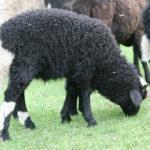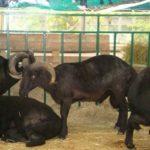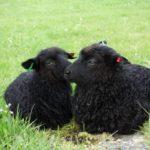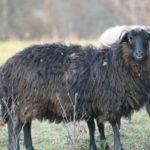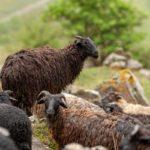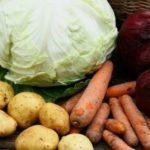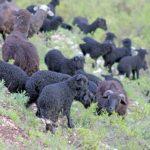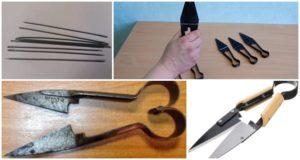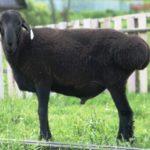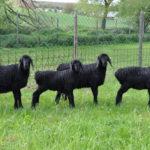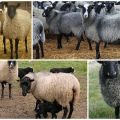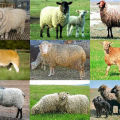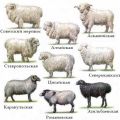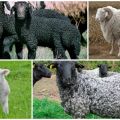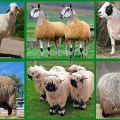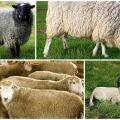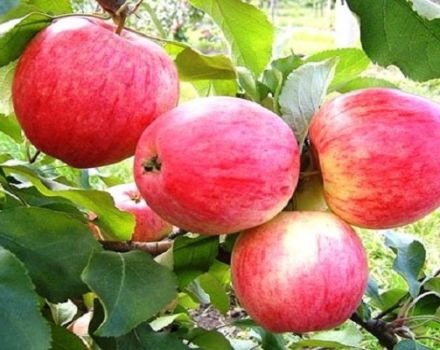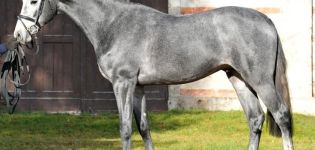Description and characteristics of sheep of the Karachai breed, maintenance rules
The Karachay breed of rams and sheep is considered unique. These are animals with spiral horns, a curved tip of the tail and black hair that have grazed for centuries in the highlands of the North Caucasus. Sheep and rams are raised for meat, wool, milk, fat tail. Animals adapt well to cold climates, but, on the contrary, cannot stand the heat.
History of the breed
Sheep of the Karachai breed comes from the North Caucasus, or rather, from the upper reaches of the Kuban, from Karachai. Since time immemorial, the local inhabitants of the highlands have been engaged in sheep breeding. The Karachai breed was created in a natural way; for many centuries, animals with the best indicators of weight and wool were selected for breeding.
In Europe, for the first time, people learned about sheep from Karachai at the beginning of the 19th century. In 1870, the French writer Bulwer Lytton wrote in one of his books about the high taste of Karachai lambs, which were prepared in the Paris restaurant "Veri". In the USSR, these animals were bred mainly for the sake of wool, leather and sheepskin. Nowadays, the Karachai breed is grown by residents of Karachay-Cherkessia, North Ossetia, Kabardino-Balkaria.
Most often in the mountains of the North Caucasus you can find animals with black wool, spiral horns and a tail tip in the form of the Latin letter Z. Karachay sheep are well adapted to the high mountain climate. For a long time, this breed grazed in mountainous areas, fed on medicinal herbs.
At home, Karachai sheep are considered the healthiest animals. They are not afraid of frost or rain. Sheep do not get sick from colds and diseases of hooves and limbs. They can graze in the meadow and be in the open air throughout the warm season, until it snows.

This breed has good immunity. Animals are bred for meat, wool and milk. It is both a meat, dairy and wool breed. True, sheep's wool is coarse and is used in the coarse cloth industry. But milk is sweetish, odorless and very fatty (fat content - from 6% to 8%). They make cottage cheese, cheese, feta cheese from it. The meat tastes like hazelnuts, very tender, juicy, sweet.
Appearance and characteristics
The Karachaevskaya breed belongs to the coarse-haired type. Their coat is thick, rough to the touch, of medium length, wavy. It contains 25 percent awn and 75 percent down. Animals are sheared 2 times a year, from one ram to 3 kg, and from a female - up to 2.6 kg of wool. The standard color of this breed is black. True, there are Karachai sheep with brownish, gray, reddish and even white wool.
This breed has a strong physique, although outwardly the animals are small. Adult rams weigh mainly 60-70 kg, rarely 80-90 kg, sheep - 40-50 kg.Most often, animals are bred for meat and fat tail fat (fat deposits in the tail area). Sheep are raised up to 9-12 months. With age, meat becomes tough. The birth weight of lambs is 3.6-4 kg. At 6 months, the animals already weigh 30 kilograms. Slaughter meat yield is about 50 percent. At 12 months, the weight of rams can reach 40-50 kg, and if they are sent to the slaughter, you get almost 20-25 kg of delicious and tender meat.
The head of the representatives of the Karachai breed is small, elongated, with a convex bridge of the nose. The horns of the rams are long, spiral-shaped, while that of the females are small, growing upward and to the sides. The neck is short but muscular. The height of the animals at the withers is 50-60 cm. The length of the body is 1.4-1.6 meters. This breed can be recognized by its 44 cm long tail, the tip of which looks like the Latin letter Z.
Females reach sexual maturity at 6 months, however, they are covered only at 1-1.5 years. They give birth to 1-3 lambs at a time. Cubs are fed with milk. In the first weeks, this product should go to feed the lambs. From the second and third month, the sheep can be milked. They give from 1 to 3 liters of milk per day with a fat content of 6-8, sometimes 9.6 percent.
There are several varieties of the Karachai breed. Karamuse is bred for the sake of black and silky wool. Kekbash are large gray-white sheep that are raised for meat. The Tumak is a hornless breed with a black, curly coat with a high fluff content (almost 80 percent) and tasty meat.
Pros and cons of Karachai sheep
Subtleties of maintenance and care
The Karachay sheep need a spacious grazing area. It is advisable to breed a herd of 3-5 animals if there is a pasture of 1 hectare. Indeed, one sheep eats from 6 to 8 kg of grass per day, and you also need to prepare hay for the winter. It is desirable that there is a reservoir nearby. One sheep drinks up to 6 liters of water per day.
To keep these animals, you need a room where they will stay at night, in heavy rain and in winter, when the pasture is covered with snow. In sheepfolds or kennels, it is necessary to equip ventilation, put windows near the ceiling, lay a bed of straw on the floor, install a manger for hay, feeders for vegetables, drinkers for water. The recommended temperature for keeping in the room throughout the year should be 10-18 degrees Celsius. One animal should have 2-3 square meters. meters of area.
It is necessary to monitor the cleanliness of the sheepfold. The litter is changed as it gets dirty, once every 1-2 days. For the winter, 100 kg of bedding material (straw, sawdust) are harvested per sheep.

What the breed is fed with
Karachay sheep can graze on pasture throughout the warm season. In summer, the main food of these animals is legumes, cereal grasses and vegetable tops (beets, carrots). Sheep can be given cereals during the earing period (oats, rye, wheat). In summer, representatives of the Karachai breed can be in the meadow for 13-15 hours a day. They are given to drink twice a day. They are driven into the room at night.
In winter, hay, silage, vegetables, and grain should be present in the diet of animals. Sheep willingly eat finely chopped carrots, fodder and sugar beets, pumpkin, zucchini. One adult a day eats 1-2 kg of vegetables, 2-3 kg of silage. True, hay is considered the main food in winter (2-4 kg per day). It is desirable that it be cut at the beginning of flowering and dried in the sun. For the winter, it is recommended to prepare hay from clover, alfalfa, and cereal grasses.In the cold period, sheep can be given oat, pea, barley, millet straw (0.8-1 kg per day).
During the stables, the sheep are fed 2-3 times a day. In between feedings, water is given. To maintain immunity in the winter, it is recommended to inject or mix pharmaceutical vitamins and minerals into food. Sheep need to be given salt all year round (10-15 g per 1 individual per day). The lack of minerals is replenished with bone meal, chalk.
Reproduction
Females of the Karachai breed reach sexual maturity at 6 months. True, it is better to cover them later, at the age of 1-1.5 years. The mating is carried out no more than once every 12 months.
Lamb
Females are mated in October-September. Pregnancy lasts 5 months and falls in the winter. Sheep need to be provided with adequate nutrition, rich in vitamins and minerals, otherwise lifeless babies will be born. In the spring, lambs are born. Before lambing, the room must be cleaned, a dry mat must be laid on the floor. The recommended air temperature in the sheepfold is 18 degrees Celsius.
The female also needs to be prepared for lambing: cut the hair behind and near the udder, feed with light food. Before lambing, the udder of the sheep increases, the genitals swell, the belly hangs down.
Childbirth can take place on its own or in the presence of a person. The female gives birth to one cub at a time, less often two or three. After the lamb appears, the umbilical cord is cut and the mucus is cleared from the nose. It is recommended to lightly milk the sheep after giving birth. This is done so that the uterus contracts faster. The afterbirth will come out in a few hours on its own. It must be buried immediately. It is forbidden to pull out the afterbirth. Immediately after lambing, the female can be given water with sugar, and after 2 hours, feed.

Raising lambs
Newborn babies should suck the mother's milk every 2-3 hours. They are kept under the female up to 3 months of age. Lambs quickly gain weight and grow by feeding on fatty milk. In the first month of life per day, they add 300 grams in weight. Being near the female, the lambs begin to taste the hay. In the summer they can be gradually transferred to the grass. It is advisable not to dramatically change the diet of animals Sudden feed changes can lead to digestive problems.
Frequent illnesses
Representatives of the Karachai breed do not suffer from colds. If animals are grazed in the historical regions of their residence, then they are not afraid of any diseases. Indeed, in high-altitude places, sheep have no opportunity to catch any infection.
In most farms, these animals will not be able to create ideal conditions. It is advisable to monitor the quality of feed, not to give them a lot of legumes and water, so that bloating does not occur due to the accumulation of gases in it. This disease is treated with a hose that is inserted into the esophagus. Improper or poor-quality feeding can lead to poisoning, metabolic diseases and non-viability of lambs.
Sheep that graze with other animals can contract various infectious diseases. As a preventive measure, animals are vaccinated against bradzot, lamb dysentery, enterotoxemia, foot and mouth disease, anthrax, and rabies. Your local veterinarian can advise on vaccinations in more detail. In addition, twice a year, animals need to be given medicines for helminths and fleas.
Breeding areas
Karachay sheep have long been raised in the North Caucasus.Currently, a huge herd of animals is bred in the Republic of Kabardino-Balkaria (breeding farm named after Attoev, "Balkaria"), as well as in the Karachay-Cherkess Republic (breeding farm "Skhauat").
This breed is very popular in North Ossetia. Recently, farmers from various regions of Russia began to breed Karachai sheep.
